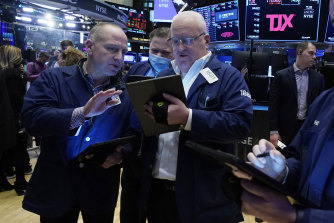The markets’ initial response to the Fed’s formal statement was positive. Stocks, after a torrid couple of weeks were up quite strongly – more than two per cent – before Powell started to speak at a post-meeting press conference.
They gave up more than that to finish the day slightly down by the time the press conference ended.
Over the past two weeks Wall Street has fallen nearly 10 per cent. The yield on two-year Treasury notes has risen 25 basis point and 10-year bond yields about 16 basis points.
What the Fed does with its bloated balance sheet is just as important for investors and the US and global economy as the timing and number of its rate increases.
What seems to have spooked investors was Powell’s unwillingness to rule out (or in) a rate rise at every Fed meeting this year, saying there was “quite a bit of room” to raise rates without threatening the labour market.
That was interpreted as the Fed taking a more “hawkish,” or aggressive, tone than anticipated even though investors should have already realised that with US inflation running at seven per cent and the Fed abruptly reversing its monetary policies late last year the likelihood is that, absent a sudden decline in the inflation rate, the Fed will be forced to move more aggressively.
Loading
The reaction to Powell’s comments, or lack of them, also was at odds with the expectations already priced into bond yields.
The yields on both the two-year notes and 10-year bonds are both up close to 40 basis points since the start of this year and an expectation of at least four rate rises this year was already baked into the markets.
It could have been worse. What the Fed does with its bloated balance sheet is just as important for investors and the US and global economy as the timing and number of its rate increases.
Since the start of the pandemic that balance sheet has grown by about $US5 trillion, injecting (along with similar action by other major central banks) an unprecedented amount of cheap liquidity into the US and global financial system.
Yet, even with strong economic growth, effective full employment and inflation raging, the Fed will still be buying bonds and mortgages – still stimulating the economy –until at least mid-March.
After that, the approach of shrinking the balance sheet by not reinvesting all the proceeds from maturing securities means that in five years’ time the Fed could still be holding $US2 trillion or more assets than it did pre-pandemic.

What seems to have spooked investors was Powell’s unwillingness to rule out (or in) a rate rise at every Fed meeting this year, saying there was “quite a bit of room” to raise rates without threatening the labour market.Credit:AP
That’s hardly an aggressive tightening of monetary policy. The vagueness of the Fedd and Powell’s commentary of the future path of interest rates and the balance sheet tends to highlight how the Fed, which misread the stickiness of inflation last year, when it was convinced the elevated rates were “transitory,” remains uncertain about the economic outlook and reactive rather than proactive.
That conforms to the new monetary policy framework the Fed adopted in 2021, in which it decided it would allow inflation to run above its target range before any monetary policy response rather than the previous policy of trying to pre-empt an outbreak by tightening monetary conditions in response to early signs of inflationary pressures.
The new policy has failed its first test given that, with US inflation is now running at 40-year highs, the Fed was forced into a complete about-face late last year; from an expansionary or “dovish” stance to a “hawkish” one, albeit that implementation of the shift in the rate structure and the start of the “quantitative tightening” is being pursued at a leisurely pace and without any defined structures.
The Fed’s own uncertainty has created confusion, and more recently some fear, in financial markets that had capitalised a conviction that the Fed would continue to maintain the ultra-stimulatory policies that had forced bond yields down (and prices up, given their inverse correlation) and inflated share prices quite dramatically through the pandemic.
Despite the obvious – unless the inflation rate falls significantly – the Fed’s hand will be forced and rates will have to rise and the balance sheet will have to be wound back more aggressively than the Fed now contemplates – until the past fortnight there’s been a complacency among investors that the Fed will be reluctant to slam on the brakes and, in the process, deflate the equity bubble its settings have encouraged.
That comforting assumption, rooted in decades of experience of the Fed bailing investors out, is now threatened, with Powell himself saying he didn’t think asset prices represented a significant threat to financial stability.
Loading
In other words, investors shouldn’t rely on the “Fed put” to bail them out, although that resolve may yet be tested.
Having fallen well behind the curve in controlling inflation, the impact on markets and investors of significantly higher interest rates and an accelerated withdrawal of excess liquidity if inflation remains at the current unsustainable levels would be, or at least should be, a secondary issue for the Fed.
The Market Recap newsletter is a wrap of the day’s trading. Get it each weekday afternoon.








